You go to your local store to get some salt for your water softener but when you get there you see that they have two types. Water softener salt in blue bags that say “Solar Crystals”, and yellow bags that say “Pellets”, which slat should you be using, Pellets or Crystals?
Pellet salt is recommended for high water usage, all-in-one (single tank) water softeners, or water softeners with narrow brine tanks to prevent salt bridges. Crystal salt is recommended for moderate to low water usage and two-piece water softeners with wider brine tanks.
Although you can usually use either pellet salt or crystal salt in most water softeners, there is a difference between the two types, and one type may work better than the other for your type of water softener.
Here’s What We Will Be Covering:
- What Are The Pros And Cons Of Water Softener Salt Crystals?
- What Are The Pros And Cons Of Water Softener Salt Pellets?
- Can I Mix Water Softener Salt Pellets And Crystals?
- What If I Can’t Get The Type Of Water Softener Salt That I Normally Use?
- Are All Water Softener Salt Crystals The Same?
- Are All Water Softener Salt Pellets The Same?
- What Is The Difference Between Salt Pellets And Salt Crystals?
- Other Types Of Water Softener Salts.
- Types Of Salt NOT To Be Used In A Water Softener!
What Are The Benefits Of Water Softener Salt Crystals?
- Water Softener (Solar) Salt Crystals Are Very Pure.
Because (Solar) salt crystals are produced by evaporating away the water from seawater to leave nothing but nearly 100% pure salt behind, solar salt crystals contain nearly 0 impurities that could settle to the bottom of the brine tank or get into the water softener control valve.
- Water Softener (Solar) Salt Crystals Are More Efficient.
Since (Solar) salt crystals consist of nearly 100% pure salt without impurities or even air pockets, every bit of the crystal is used for making brine and almost nothing is wasted.
- Water Softener (Solar) Salt Crystals Dissolve Completely.
Impurities including minerals other than salt can cause some of the salt crystals that are mined from the earth to not dissolve completely and settle to the bottom of the brine tank.
- Water Softener (Solar) Salt Crystals Are Often Less Expensive.
Water softener salt crystals require less processing which will often help keep their overall price down.
Although the price difference between salt crystals and salt pellets is usually minimal, when you consider the amount of bags required for a water softener per year, the savings can really add up.
What Are The Disadvantages Of Salt Crystals?
- Salt Crystals Are Small With Irregular Edges.
Although the edges of salt crystals are not exactly sharp, they are fine enough to allow the crystals to lodge into corners and crevices in a water softener brine tank which can be the beginning of a salt bridge.
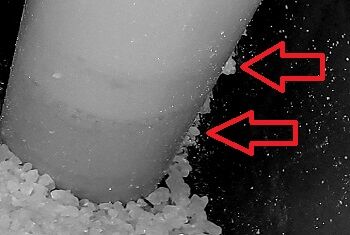
- Salt Crystals May Contain Dirt And Debris.
Some brands of water softener salt crystals are not processed as much as others. These less expensive brands may contain large amounts of dirt and debris which can cause problems with brine float assemblies and cause excessive wear and tear in a water softener control valve.
What Are The Benefits Of Water Softener Salt Pellets?
- Water Softener Salt Pellets Are Larger And Have Rounded Edges.
Water softener pellet salt is recommended for use in all-in-one (single piece) water softeners and water softeners with square or narrow brine tanks because the larger rounded shape of the pellets is less likely to get lodged in corners or crevices of a brine tank.
The rounded shape of water softener salt pellets provides less surface area for the pellets to make contact with each other so there is less chance of the pellets clumping together.
- Water Softener Salt Pellets Are Very Clean.
Because the salt granules used to make water softener salt pellets have been cleaned and processed, there are nearly 0 unwanted impurities in the pellets.
What Are The Disadvantages Of Salt Pellets?
- Salt Pellets Do NOT Dissolve Completely.
After a water softener, the salt pellet dissolves there is a very small amount of the pellet that does not dissolve in water and will settle to the bottom of the brine tank.
These leftover portions of the salt pellets will build up at the bottom of the brine tank and eventually become a very dense block that can be difficult to remove.
- Salt Pellets Can Be More Expensive.
The extra processing of water softener salt pellets generally results in the price of the salt pellets being slightly higher than regular water softener salt crystals.
Although water softener salt pellets are often recommended for all-in-one (one-piece) water softeners and water softeners with square and narrow brine tanks, less expensive salt crystals normally will work fine as well.
- Salt Pellets May Contain Phosphates That May Damage Some Water Softener Resins.
There are special water softener resins called (Silica Crystal) that are used for high iron removal from water and can increase the pH of acidic water.
It is NOT recommended to use water softener pellets or any other water softener salts that may contain phosphates which can damage “Silica Crystal” water softener resins.
Can I Mix Water Softener Salt Pellets And Crystals?
I normally recommend staying with either water softener salt pellets or salt crystals and not mixing them together. Smaller salt crystals can lodge between larger salt pellets and stick together forming a salt bridge.
What If I Can’t Get The Type Of Water Softener Salt That I Normally Use?
If you accidentally purchased water softener salt pellets or crystals that you don’t normally use, or the salt that you normally use is unavailable, I recommend that you let the existing salt in your brine tank get down to at least halfway down the tank before adding the new type of water softener salt.
Once you have used up the new salt, let the salt drop down below the half tank level again before going back to the salt that you normally use.
Are All Water Softener Salt Crystals The Same?
No, there are many different brands of water softener salt crystals and (Solar) salt crystals that may contain different amounts of impurities and debris in them.
Are All Water Softener Salt Pellets The Same?
Most water softener salt pellets are very similar and will work equally well when pellet salt is recommended for your type of water softener.
The process of making water softener salt pellets makes them all very pure and similar.
How Are Salt Pellets, Salt Crystals And Solar Salt Crystals Produced?
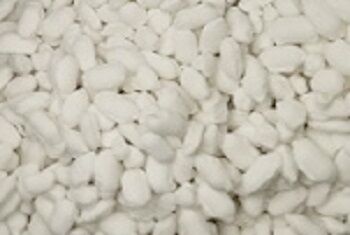
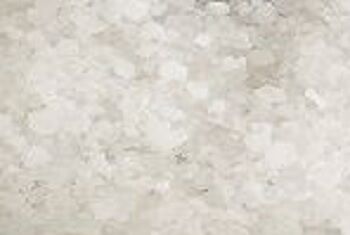
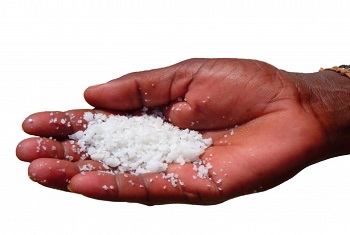
What Is In Water Softener Salt Pellets?
Water softener salt pellets are about 99.9% pure salt. Because water softener salt pellets are thoroughly processed, they do not contain as many impurities as other types of water softener salts.
What Is In Water Softener Salt Crystals?
Water softener salt crystals that are mined from the earth are approximately 98.5% pure salt and may contain minerals other than salt. Because salt crystals are mined from the earth, they may contain dirt or debris that has been extracted along with the salt itself.
Water softener “Solar Salt” crystals will generally be between 99.5% and 99.9% pure depending on the brand of salt. Solar Salt crystals will generally be free of other minerals besides salt and are generally free of dirt and debris.
The Size And Shape Of Salt Pellets And Salt Crystals Makes A Difference.
Water softener salt pellets are rounded for a reason!
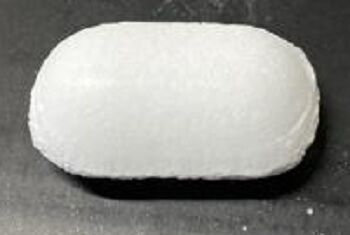
The rounded shape of water softener salt pellets is to make the pellets less likely to interlock with each other or get lodged in corners of a brine tank which can lead to salt bridging.
Salt bridging is when pieces of water softener salt cling together, or to the surfaces of a water softener brine tank and create a crust that does not collapse to the bottom of the brine tank.
When this happens, the water softeners brine tank will look full but in reality, there is no salt in the bottom of the tank to create a brine for the water softener.
Although salt crystals will generally not cause salt bridging in a water softener brine tank, salt pellets are generally recommended for all-in-one (one-piece) water softeners or water softeners that have square or narrow brine tanks.
Other Types Of Water Softener Salts.
Some water softener salt (Pellets and Crystals in GREEN or Red/Orange bag) will contain additives to help remove iron from your water or to help keep the inside of your water softener clean. These additives are generally only helpful for problem water situations and are NOT normally needed.
Types Of Salt NOT To Be Used In A Water Softener!
Road salt crystals are not to be used in any water softener because they contain far more impurities than recommended for water softener use.


can you mix treated soft water with untreated water to a level of around 300 calicum hardness with a three way value. The 0 level causes a skin rash, but the plumbing fixture are great.
Hello Bowcut Ron and thank you for the question.
Yes, you can open the bypass valve of a three-way bypass to allow some untreated water to mix with the softened water, but remember that you will be adding TOTALLY untreated water to blend with the softened water.
Iron, hardness, or any other characteristics in your untreated water will get mixed with your softened water.
Also, it is usually tricky to open the valve just enough to allow a precise amount of untreated water to blend with your softened water and if you open the valve too much, you might allow all of your water to go through the bypass rather than through the water softener.
You can try to open the bypass valve just a tiny bit and try that for a few days to see if it works better for you, but if you find that the salt in your water softener stops going down, you may have opened the bypassed valve too much and none of your water is being softened.
I hope this was helpful.
Paul
How often should I dump remaining salt and the dirty residue, clean the brine tank and start anew. I use roughly 2500 to 3000 gallons per month of softened water. I just did the cleaning after about 6 1/2 years and the remaining water and salt were sort of muddy looking. I have been using the crystals since I installed this softener and have been very pleased with it. It is a standard upright tank with a Fleck controller.
Thanks for your help
Hello Tim and thank you for the question.
A little dirty water will generally not cause any problems with a Fleck control valve or the water softener resin in the tank.
The dirty water is likely caused by small amounts of dirt that are inside the bags of salt crystals themselves.
The brine from the brine tank is only used to regenerate the water-softener resin and then it is rinsed away.
I don’t think that you need to clean your brine tank more often than you did unless you feel better doing so.
Make sure to use very pure “solar crystal” salt if possible to keep as much dirt out of the brine tank as possible.
I hope this was helpful.
Paul
Hey Paul, I recently had to switch types of salt in a Kinetico softener due to unavailability of the pellet type. The blue bag just says “Premium Softener Salt” (of course it is) but does not say “crystal” or “solar.” I checked online and by the product code it is solar. In a short time my brine tank was sending water out the overflow, and water level is far higher than normal. Is this a problem due to the wrong type of salt, or is my unit just in need of a good cleaning and maintenance? Been online for 27 years, never touched it except to add salt. Great unit. City water.
Hello Randy and thank you for the question.
I would say that the salt that you purchased should be fine and not actually the cause of the water flowing out of the overflow.
It sounds like some dirt from inside of the brine tank got stirred up when you added the new salt and then the water softener regenerated shortly after and drew some of the dirt into its shut-off valve causing it not to shut off correctly.
See my article “Why is my water softener overflowing” for more info.
I would bypass the system to stop the water flow, then carefully remove the brine float and clean the shut-off assembly.
If you don’t feel comfortable about working on the system yourself, contact your local Kinetico dealer to service the system.
It is VERY important to use very pure salt in a Kinetico water softener, after fixing the problem, go back to salt pellets as soon as possible and NEVER let your brine tank go empty to prevent dirt from being stirred up when adding new salt.
I hope this was helpful.
Paul
Hey Paul,
First off, thank you for all of the great advice. Just came across your site yesterday when cleaning my brine tank. Was just looking for info on regeneration. So, I do need advice though about water pellets(Morton). Had bought two bags recently at the local True Value Hardware store, when I dumped one in the brine tank, I noticed they weren’t the usual bright white that I’m used to seeing. They appeared dirty. Needing the salt, I didn’t try to remove it and hoped it would work out. The water appeared dirty after a few regenerations, so I did not use the other bag, and purchased additional bags at Costco. Cleaned the brine tank. While not AS dirty looking initially, after adding water, these bags look similarly dirty after having done a thorough cleaning of the brine tank. I’m going to have to use this for now, but how does this impact my water quality ? Any help would be appreciated. Thanks again for THE most thorough website.
Hello Jim and thank you for the question.
The dirty-looking dust that you saw on the pellet salt was most likely just salt dust created by the salt pellets rubbing up against each other. The bag may have been around for a while and been shipped back and forth or moved many times within the store that you purchased it from.
The bag may have even been stored away a few years ago and shuffled around several times creating the salt dust that you see on the pellets.
The dust also could be the binder material that is used to hold the salt into the pellet shape. This binding material would not be harmful to your water softener or its resin but it can build up on the bottom of your brine tank over time. If you find that you have many bags with this dust, you can give the salt a quick rinse in a bucket and then dump the rinse water down the drain before adding the salt to your water softener.
But if it was just a few bags, I wouldn’t worry about it.
I hope this was helpful.
Paul
Paul,
Wow, thank you for the quick reply, and on a weekend no less ! You’re definitely taking some of the mystery out of water softeners.
Not sure if I should’ve mentioned the tablets were of a tan/brown color. I found some other folks online referring to dirty tablets from Morton on a forum. I’ll include : https://terrylove.com/forums/index.php?threads/morton-softener-salt-quality-getting-worse.97062/
Seems like an issue with Pool Salt from Morton as well.
Your detailed explanation eased my anxiety about compromised water. Much appreciated. I wonder if I may ask a couple of more questions(I won’t make this a habit). I understand if you cannot reply. I noticed after cleaning the brine tank, when I did a manual regeneration, and again during an auto regen, during the final phase, where the water is being replaced in the brine tank, for about 30 seconds, the hose from the media tank to the brine tank was shaking violently to the point I had to hold it where it connects to the brine tank for fear of it coming loose from the connection in the tube to the check valve and float. Sounded like it was maybe drawing air while trying to replace water, like if you don’t “prime” a pump. Could there be water in the media tank ? Also, is the float supposed to shut off the water returning to the tank, or does the cam on the timer do that ? Seemed like the cam did it on mine, so is the float then just to prevent overflow ? Again, I know time is money so, no sweat if you don’t have the time, you’ve already helped plenty. Be well, Jim
Hello Jim and thank you for contributing to the topic.
The jumping may be caused by air in the line or sometimes it can simply be caused by inconsistent water pressure but either way, it is not uncommon for a brine line to jump when filling the brine tank.
The brine fill cycle is normally controlled by the control valve which will shut off the water filling the brine tank after a certain amount of time. The float inside of the brine tank is a secondary shut-off in case the water in the brine tank goes too high.
I hope this was helpful
Paul
Hi Paul,
Thanks again for the info. Good to know it’s somewhat normal for the line to jump. I secured the line with strong string and a screw to a 2×4 that the brine tank is next to(softener and tank are in a closet that has exposed studs on the inside). Held up well during regeneration.
In my last reply I meant to ask, “Could there be AIR, in the media tank.”, not water. Should’ve proof-read better.
Anyhow, it’s been a pleasure going back and forth with you, I do appreciate it a lot. Hopefully it will help someone else as well. Helluva thing you’re doing, providing free advice. You really helped me. If I can return the favor, let me know. I wish you much success in business, and life in general. Thanks again Paul. Be well. Jim
Hello Jim,
There certainly can be some air bubbles in the media tank of a water softener especially right after the water softener has regenerated because it uses a strong flow of water which may contain dissolved air bubbles.
Because most water softeners refill their brine tank at the end of their regeneration cycle, it is not uncommon to have some air bubbles in the media tank but not all water softeners refill their brine tank with softened water from the media tank.
But if your water softener does refill its brine tank with water from the media tank it could very well contain air bubbles that could contribute to the brine line jumping.
Thanks again Jim
Paul